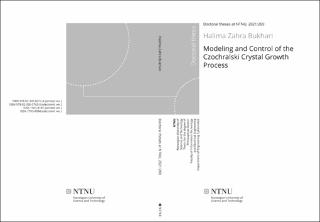| dc.description.abstract | This thesis provides the basis for improved control of the Czochralski (Cz) process – a process used on a commercial scale to produce monocrystalline silicon (Si) ingots. This is done by developing a model for the crystal radius measurement that is, in turn, used in the process control. This model enables the design of a modified control structure that accounts for the physics of the process and removes the main limitation in the achievable performance for the crystal radius control while still being simple for the operators to understand. (a.) At present, the Czochralski crystal pulling process is an industrialized process that is not sufficiently automated. This process involves complex heat and mass transfers, thereby leading to both time- and spatially- varying operating conditions. Therefore, the majority of the plant operations rely on intervention by skillful operators, running these operations rather crudely on empirical knowledge of the process.
(b.) There is no in-situ measurement of the controlled variable, i.e., the diameter of the crystal ingot produced by the Cz process. Instead, the control of this process depends on some estimated measurement of the crystal ingot diameter. Furthermore, the measurement related to the melt temperature is also indirect. This indirect measurement, not being accurate enough to the actual temperature, hinders the control capability by delaying the appropriate temperature feedback for timely corrective action.
While the aim is to improve the control of the Cz process by skilled operators, thereby making the operation less dependent on the skills of the individual operators, there is still a need to make the process control both acceptable and understandable for the operators. While very detailed models exist, typically using some finite element model of the plant, the lack of online measurements makes it hard to update such models during the production of individual ingots. These factors limit the complexity of a realistic control approach. While it is desirable to make effective use of the process knowledge in the controller design, the model(s) used for controller design should be simpler yet robust rather than very detailed.
In light of the above, the model-based control regime adds the knowledge of plant dynamics to the overall control system that was otherwise tuned through empirical knowledge only.
A detailed investigation into the mechanism of an anomaly exhibited by the measurement of the crystal diameter is taken up at the first stage. As a common practice in the Cz industry, this measurement relies on the image of the growing ingot obtained via a CCD camera. In a dynamic simulation, the measurement signal manifests its anomalous trend by moving initially in a direction opposite to that of the actual response of the crystal diameter. The measurement anomaly is crucial because it poses a limiting factor in the design of the feedback control system. Therefore, a 3D ray-tracing scheme was developed to determine the dynamic response of the camera measurement, also commonly referred to as the bright-ring radius signal. The dynamic analysis of the measured signal serves as a guideline for designing effective radius control, undertaken at the next stage.
Before proceeding with the control design, the inverse dynamic characteristics were first determined/quantified by linearizing the Cz growth model. It is noteworthy that the output of the Cz growth model is the camera image, modeled by the 3D ray-tracing simulation. Furthermore, in the context of linear control theory, any linear system with the inverse response in measurements is represented by a state-space model with right-half-plane zero(s).
Systems with right-half-plane zeros also fall into the category of non-minimum phase systems. These systems suffer from fundamental bandwidth limitations.
To mitigate this undesired inverse response, this Ph.D. study proposes a combination of a parallel compensator and a feedback controller. The actual diameter signal is void of this inverse behaviour as it is merely an artifact caused by the system measurement technique. Therefore, the use of parallel compensation is a feasible approach for eliminating the inverse characteristics without altering the system dynamics, but enabling a faster diameter control. This technique for removing the non-minimum phase characteristic enables faster diameter control without pushing against the stability limitations. The designed compensator and controller are tested and validated in the nonlinear environment under the influence of temperature variations, which act as disturbances at the crystallization/growth interface.
This Ph.D. project is a part of the ASICO project (Advanced SIngle crystal Control growth for high-end photovoltaics) involving Norsun, Sintef, NTNU and TU Dresden, Germany. The ASICO project (‘project No. 256806/O20’) is a BIA project with funding from the Research Council of Norway. | en_US |
